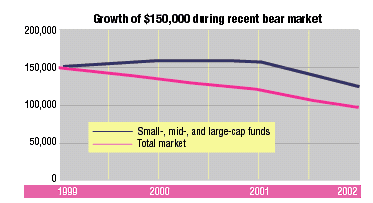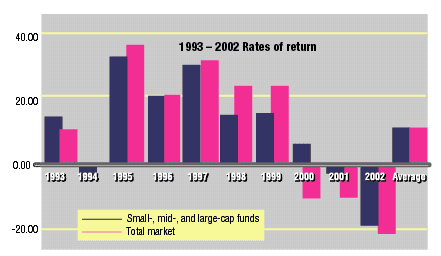
HOT TOPICS LIST
- Strategies
- Stocks
- Buy
- Investing
- Brokers
- Psychology
- Interviews
- Accumulate
- Sell
- Hold
- Spotlight
- Websites
- Candlestick Corner
- Gold & Metals
- Options Trading
LIST OF TOPICS
INVESTING
Maximum Diversity
07/30/03 03:34:16 PM PSTby Eric J. Witkowski
You can tame the bear--if you diversify.
| Look back at the market performance of the past few years and consider this. If you had made a $150,000 investment in a stock market index fund at the beginning of 2000, your investment would have been worth about $94,000 at the end of 2002. However, that same investment, if divided equally between large-capitalization, mid-capitalization, and small-capitalization index funds, would have been worth about $127,000 after the same time period (see Figure 1). Further, that strategy diversified into three index funds would have saved you about $900 per month on a $150,000 investment during the recent three-year slide (2000 through 2002).
Figure 1: Growth of $150,000. Here's how an investment in three different market cap index funds would have fared against the same investment in a total market index fund.
MARKET VALUE WEIGHTINGWhy is there such a disparity between these two investment portfolios? Market value weighting is the key. Market value weighting means that larger companies' performances have greater impact on an index's movement. Most of the index funds in existence today are tied to market value-weighted indexes such as the Standard & Poor's 500, Russell 2000, and Wilshire 5000. As a hypothetical example, suppose you invested $1,000 in an index fund that tracked just two companies' stocks. Company A is worth $25 billion and company B is worth $500 million. Your $1,000 investment would buy $980.40 of company A's stock, but only $19.60 of company B's stock. If company A loses 5% over the next year and company B gains 50%, you would still lose money — 3.9%. When you invest in a total stock market index fund that includes small and mid-sized companies, the performance of the big companies holds sway over your returns. That isn't to say that a total market index is bad, or that funds that are tied to total market indexes such as the Wilshire 5000 should be avoided. Quite the contrary; the Wilshire 5000 index has done well over the years. When the big caps had their great bull market run from 1995 through 1999, you would have thought investing in them was the greatest thing since peanut butter and jelly. But if you got in on a total stock market index fund in early 2000, it probably left a bad taste in your mouth. By investing in multiple index funds, you can avoid such severe declines in your portfolio and the indigestion that invariably follows.
HOW INDEX FUNDS WORKIndex investing is a strategy that tries to mirror the performance of the stock market, or a sector of the market, without bias as to whether a stock is undervalued or overvalued. Indexes are made up of all the stocks within a group, or a sampling of enough stocks to accurately reflect a group. For example, the Standard & Poor's Mid-Cap 400 index is made up of 400 medium-sized companies from all the various market sectors. These include utility, energy, financial, industrial, service, retail, health, and technology companies. A fund that is tied to the S&P Mid-Cap 400 buys the same stocks and in the same proportion as the index. History shows that funds using this passive investment approach have consistently been ranked among the top third of stock mutual funds, year in and year out.
ECLECTIC INVESTMENTIf you really want to invest in the whole stock market, you must divide your investment into three different index funds. One fund will track small companies, one fund will track medium-sized companies, and one fund will track the big companies. This investment strategy is the ultimate in diversification. Sometimes large companies do well when the small ones falter. At other times medium-sized companies shine. You just never know which will do best, so it pays to be eclectic. To get the most accurate picture, we need to look at what happens during both bull and bear markets (see Figure 2). As you can see, during the bull market of 1995 through 1999, the Wilshire 5000 total market index held a slight edge over the S&P 500, Mid-Cap 400, and Small-Cap 600 index funds (divided equally). But the bottom fell out of the Wilshire 5000 during the bear market of 2000-2002.
Figure 2: Rates of return: 1993-2002. Here's a look at the effect of buying three different market cap index funds.
An investment made in the Vanguard Total Stock Market Index Fund (tied to the Wilshire 5000) lost 10.6% in 2000, 11% in 2001, and finally 21% in 2002. By contrast, an investment divided equally between the Dreyfus S&P 500 (large caps), the S&P Mid-Cap, and the S&P Small-Cap stock index funds would have fared much better, gaining 6.2% in 2000 before losing 2.5% in 2001 and losing 18.4% in 2002.
BOTTOM LINEInvesting in index funds can be well worth the decision, but because of market value weighting, in order to be truly diversified you must include a small-cap and a mid-cap fund to go along with your large-cap fund. A total market index fund won't give you the same level of diversity, and during these uncertain times in the market, diversity is most likely to protect your nest egg.
Eric Witkowski may be reached at ericwit1@surferie.net. Data courtesy of Dreyfus.com, Vanguard.com, and Indexfunds.com
Current and past articles from Working Money, The Investors' Magazine, can be found at Working-Money.com.
|
PRINT THIS ARTICLE

|

Request Information From Our Sponsors
- StockCharts.com, Inc.
- Candle Patterns
- Candlestick Charting Explained
- Intermarket Technical Analysis
- John Murphy on Chart Analysis
- John Murphy's Chart Pattern Recognition
- John Murphy's Market Message
- MurphyExplainsMarketAnalysis-Intermarket Analysis
- MurphyExplainsMarketAnalysis-Visual Analysis
- StockCharts.com
- Technical Analysis of the Financial Markets
- The Visual Investor
- VectorVest, Inc.
- Executive Premier Workshop
- One-Day Options Course
- OptionsPro
- Retirement Income Workshop
- Sure-Fire Trading Systems (VectorVest, Inc.)
- Trading as a Business Workshop
- VectorVest 7 EOD
- VectorVest 7 RealTime/IntraDay
- VectorVest AutoTester
- VectorVest Educational Services
- VectorVest OnLine
- VectorVest Options Analyzer
- VectorVest ProGraphics v6.0
- VectorVest ProTrader 7
- VectorVest RealTime Derby Tool
- VectorVest Simulator
- VectorVest Variator
- VectorVest Watchdog


